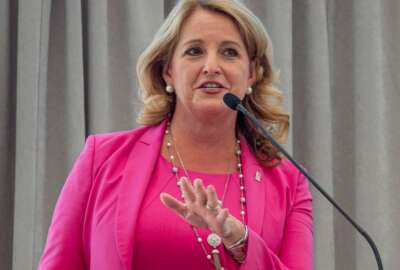October 31, 2025
Subscribe and listen to the Fed Gov Today Podcast anytime on Apple Podcasts, Spotify, or at FedGovToday.com.
When the federal government reopens after a shutdown, agencies don’t simply flip a switch and go back to normal. Systems, people, and priorities all need attention — fast. On Fed Gov Today with Francis Rose, former Federal Chief Information Officer and current CEO of Kent Advisory Services, Suzette Kent, explains how agencies can effectively restart operations after a shutdown by focusing on three key concepts: people, risk, and what’s “on the clock.”
Kent knows what it’s like to manage through chaos. Having served as Federal CIO during the longest shutdown in U.S. history, she describes the process of restarting government work as a complex balancing act. Her first priority is always people — both the federal employees returning to work and the citizens who rely on government services. Kent says the first focus must be on the activities that directly impact people, like processing paychecks, issuing benefits, and getting employees back into critical roles. For instance, making sure air traffic controllers return to full strength or ensuring SNAP benefits and Medicare payments go out on time are immediate must-do tasks.
She explains that this process feels a lot like triage. When agencies reopen, leaders need to identify which functions have the biggest impact on citizens and staff — and tackle those first. Kent recalls that during the last shutdown, agencies even had to conduct out-of-cycle payrolls because employees had missed multiple paychecks. She emphasizes that these early steps are about restoring trust and stability while clearing backlogs that could ripple across multiple agencies.
conduct out-of-cycle payrolls because employees had missed multiple paychecks. She emphasizes that these early steps are about restoring trust and stability while clearing backlogs that could ripple across multiple agencies.
The second concept Kent highlights is risk — the unseen problems that build up while people are away. “When people are not at work and they’re not doing their normal things, nefarious activities creep in,” she warns. That means leaders need to watch for expired passwords, unauthorized access attempts, and data integrity issues. But it’s not just cybersecurity. Kent notes that many agencies face broader risks: hardware delays, missing data, and broken processes caused by time gaps in critical workflows. When everything resumes at once, these small risks can snowball quickly if not addressed head-on.
The third concept — what’s “on the clock” — refers to every deadline or time-sensitive process that stalls during a shutdown. Kent explains that many government operations depend on strict timelines: open comment periods for regulations, grant submissions, audits, and certification deadlines. When no one is working, those timelines expire. Agencies must decide what to extend, what to restart, and what requires renegotiation. For example, she mentions agencies had to reschedule audits and oversight reviews after the last shutdown because there simply wasn’t enough capacity to do everything at once.
Kent also stresses the importance of understanding cross-agency dependencies. Payroll, onboarding, and security processes often rely on coordination between multiple departments — and a delay in one can stall many others. She recalls instances where employees couldn’t even enter buildings because their security badges had expired during the closure.
Ultimately, Kent’s message is clear: a successful restart requires planning, collaboration, and prioritization. Agencies must care for their people first, tackle emerging risks quickly, and get back on schedule — all while learning from past shutdowns to prepare for the next one. As she puts it, “The priority is mission recovery.”
